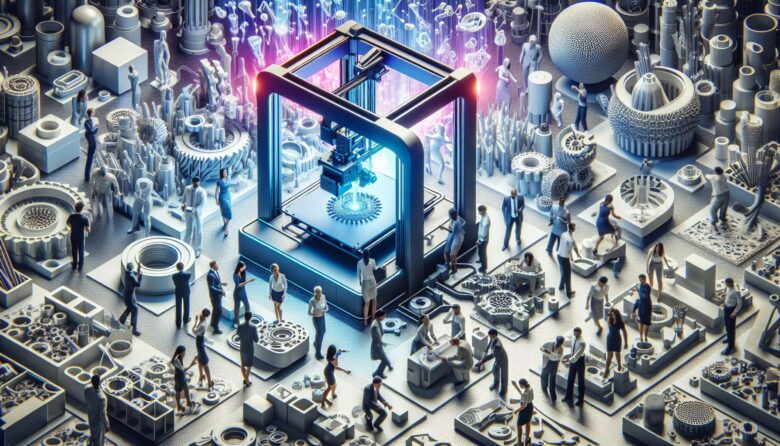Introduction
In today’s rapidly evolving technological landscape, 3D printing is making waves as one of the most groundbreaking advancements of our time. This cutting-edge technology is revolutionizing the manufacturing industry by offering endless possibilities for creating intricate, customized products with unparalleled precision. From prototyping to production, 3D printing has opened up a world of opportunities that were once unimaginable. In this blog post, we will explore the fascinating world of 3D printing and its widespread impact on various industries.
What is 3D Printing?
At its core, 3D printing, also known as additive manufacturing, is a process of creating three-dimensional objects using digital models. Unlike traditional manufacturing methods that involve subtractive processes, such as cutting or drilling, 3D printing involves adding successive layers of material until the desired object is formed. This additive nature of 3D printing allows for complex geometries and intricate designs that were previously difficult or impractical to produce using conventional methods.
How Does 3D Printing Work?
The 3D printing process begins with a digital design or model, typically created using computer-aided design (CAD) software. The file is then sliced into multiple cross-sectional layers, which serve as instructions for the 3D printer. The printer interprets these instructions and deposits material layer by layer, be it plastic, metal, ceramics, or even biomaterials, to gradually build the final object.
There are various 3D printing technologies available, each utilizing different materials and methods. Some of the most common types include:
- Fused Deposition Modeling (FDM): This technology uses a heated nozzle to extrude thermoplastic materials, such as ABS or PLA, layer by layer. FDM is widely used due to its affordability and versatility.
- Stereolithography (SLA): SLA employs a vat of liquid photopolymer resin that is cured by a laser or UV light, creating solid layers one at a time. SLA is known for its high level of detail and accuracy.
- Selective Laser Sintering (SLS): SLS uses a laser to sinter powdered materials, such as metal, plastic, or nylon, layer by layer, fusing them together. It is commonly used for functional prototypes and production parts.
- Digital Light Processing (DLP): Similar to SLA, DLP utilizes a projector to cure a vat of liquid resin layer by layer. DLP offers faster print times but sacrifices some detail compared to SLA.
These are just a few examples of the wide array of 3D printing technologies available today. Each one has its own unique advantages and limitations, making them suitable for different applications and industries.
Applications of 3D Printing
-
Prototyping and Product Development
One of the most significant applications of 3D printing is in prototyping and product development. This technology allows designers and engineers to quickly produce physical models, validate designs, and make necessary adjustments before moving into full-scale production. The ability to iterate and test designs rapidly significantly reduces development time and costs.
Furthermore, 3D printing enables the creation of complex prototypes with moving parts, intricate features, and internal structures that traditional methods struggle to replicate. This freedom to experiment and explore different design possibilities is invaluable for innovation and pushing the boundaries of what is achievable.
-
Aerospace and Automotive Industries
The aerospace and automotive industries have eagerly embraced 3D printing due to its ability to produce lightweight yet robust parts with complex geometries. This enables the design and production of aircraft components and car parts that are not only more fuel-efficient but also exhibit enhanced performance characteristics.
For example, General Electric has successfully utilized 3D printing to manufacture fuel nozzles for their jet engines. The resulting nozzles are not only 25% lighter but also more durable and efficient compared to their traditionally manufactured counterparts. Similarly, automotive manufacturers employ 3D printing to create lighter and more resilient parts, improving overall vehicle performance and fuel economy.
-
Healthcare and Biotechnology
The healthcare and biotechnology sectors have also experienced significant advancements through 3D printing. This technology enables the production of customized medical implants, prosthetics, surgical instruments, and anatomical models with exceptional precision. The ability to tailor medical devices to each patient’s unique anatomy has transformed patient care and improved surgical outcomes.
Organ printing, a groundbreaking application of 3D printing, holds the promise of creating functional organs using a patient’s own cells. While still in the experimental stage, scientists envision a future where organ transplantation could be revolutionized, ultimately saving countless lives.
-
Architecture and Construction
In the field of architecture and construction, 3D printing enables the creation of complex and intricate building components with utmost accuracy. This technology allows architects and engineers to push the boundaries of design and construct previously unachievable structures.
Not only can 3D printing accelerate the construction process, but it can also reduce material waste and labor costs. Large-scale 3D printers can fabricate building materials on-site, eliminating the need for lengthy transportation and assembly processes.
Conclusion
From its humble beginnings as a futuristic concept, 3D printing has emerged as a game-changer across numerous industries. The ability to transform digital designs into physical objects with unprecedented precision has opened up a world of possibilities, pushing the boundaries of innovation and creativity.
As the technology continues to advance, we can expect even more remarkable breakthroughs and applications in the future. From personalized medical treatments to sustainable manufacturing practices, 3D printing holds the potential to reshape our world and revolutionize the way we produce, create, and invent.
With an ever-expanding range of materials and continuous improvements in printer capabilities, the only limit to what can be achieved through 3D printing is our imagination. The future is undeniably bright for this incredible technology.



